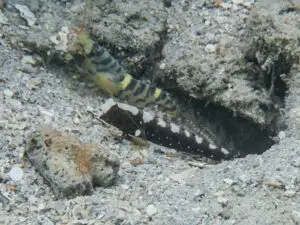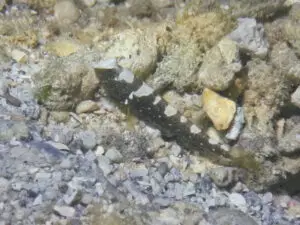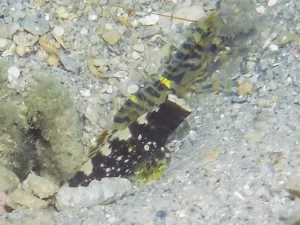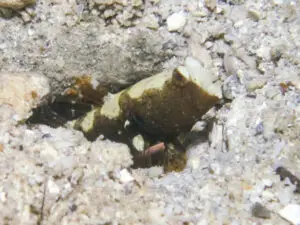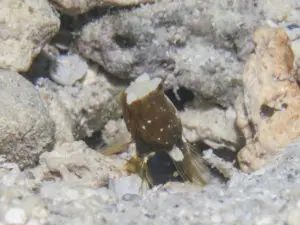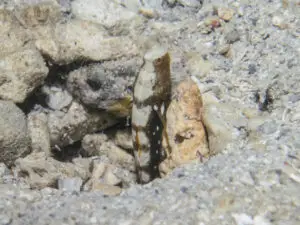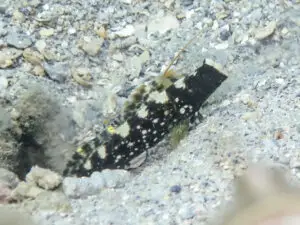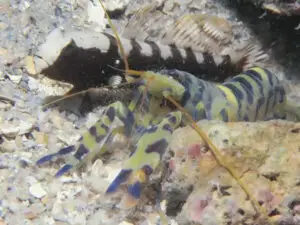Saddled Shrimpgoby
Cryptocentrus leucostictus
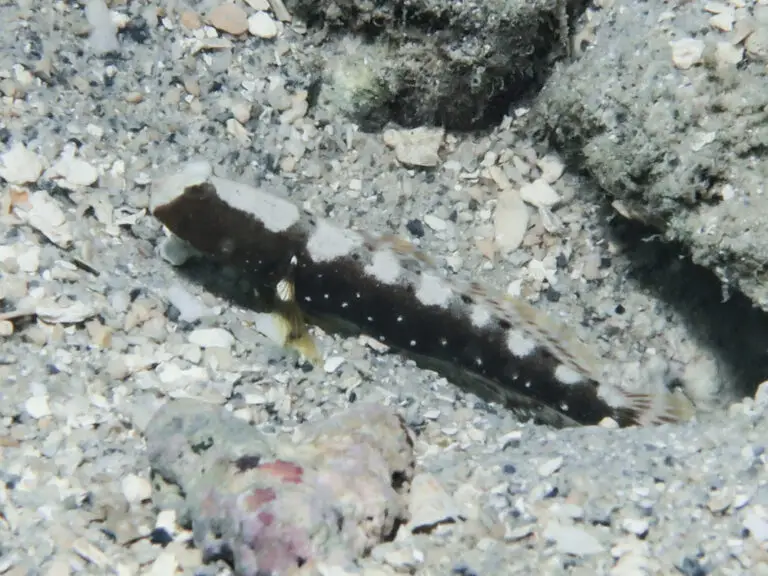
Saddled Shrimpgoby
Cryptocentrus leucostictus
(Gunther, 1872)
Description
This is a fairly small shrimpgoby, around 6 cm in length.
Body design
The body is dark brown, less speckled than C maudae, with a distinctive white face and eight well defined closely spaced saddles on the dorsum. The white face extents to the lower lip and may be continuous with the first dorsal patch. There is a well marked row of about 8 small white spots on the lateral aspect. In some individuals these may be overlaid by many white patches laterally but the line of 8 white spots remains distinct. This should not be confused with C maudae which has fine speckles, not spots or patches and a different dorsal fin. .
Fin design
The first dorsal fin is white with two irregular brown bands, the upper being of uneven width with black centres to the wide portions.
The second dorsal fin is unmarked transparent yellow.
The caudal fin appears to be unmarked with a yellow wash.
The pelvic fins are black with white spots
The anal fin is white with with a grey midline stripe and a black edge
The pectoral fin is unmarked translucent yellow with a conspicuous white patch at the base.
Variation
The illustration in Fishes of Australia, sourced from John Randall, shows the dorsal view of a very pale individual. No dorsal saddles are visible. Dorsal, anal and caudal fins have rows of white spots along the fin rays. A line of seven pigmented midline patches can be seen laterally.
The large white patch at the origin of the pectoral fin is clearly shown.
We see some individuals with a continuous white dorsum (looking like C albidorsus). These have been small and the variation in markings may represent immaturity.
Diagnostic features
The white face and series of white saddles on a dark speckled background are conspicuous.
The best diagnostic feature is the plain pectoral fin with a well defined white patch. The white colour of the face is continued into the first saddle without a break. The row of white spots laterally is distinctive.
Similar species
Cryptocentrus maudae, Maude’s Shrimpgoby, is a larger fish with prominent speckles all over the body. The pectoral fin is speckled with white. There is a break between the white of the face and the first saddle.
Cryptocentrus albidorsus, the White-back Shrimpgoby is uniformly white the whole length of the dorsum. It is very small and more obviously contrasting white and black.
Cryptocentrus nigrocellatus, the Blackspot Shrimpgoby has a large distinctive ocellated spot just in front of the pectoral fin.
Natural History
Habitat
Cryptocentrus leucostictus lives in very shallow water in coarse sand, finely broken shell fragments and larger pieces of old storm damaged Acropora coral. In this shallow water the sand is constantly turned over by the rising and falling tide and fine sand is washed away leaving a substrate too unstable for easy burrow construction. Burrows are commenced close to larger coral fragments and are dependent on coral pieces for support.
Behaviour
We have found Cryptocentrus leucostictus in two small areas at the Low Isles. The first is along the bay side of the sand spit near the mangroves. It shares this habitat with the similar looking C. maudae, C leptocephalus and Ctenogobiops aurocingulus. Together they form a community that is subjected to much stress from high water temperatures as the as the water gets shallower with the falling tide and then having the burrow entrance left high and dry at low tide. If the low tide turns in the middle of the day the shrimps and gobies are restricted to only brief periods at morning and evening when feeding is possible. The night time tide is not available as these are diurnal creatures.
Within the small area this community inhabits there is partition by habitat with Cryptocentrus leucostictus and its Blue and Yellow Shrimp restricted to an inhospitable looking region of dead coral fragments and coarse sand. Here burrow integrity is dependent on roof props of coral, and the shrimp has to be more of a constructor than a bulldozer.
The second population lives rather unexpectedly in a narrow zone on the trade wind exposed southern fringing reef. This reef is shallow, from 0 to 2m, over its 200m width. It is a patchwork of different zones: sun damaged Porites, healthy Acropora corals, bare coral rock with a covering of algae, areas with a rich variety of healthy algal species and areas of mixed coral with 2-3 square metre sand patches. A variety of snapping shrimp live here but the only shrimpgobies we find are Cryptocentrus leptocephalus and C. leucostictus living, not in the smooth clear areas of sand, but in a small untidy patch of coarse sand, shell fragments and old broken pieces of coral with scattered algae. The healthy algae is also important and we have watched the Blue and Yellow Shrimp working hard to pull quite large pieces of Padina algae into the burrow. There is no algae growing on the larger smooth sand patches of this reef.
Published distribution:
Andaman Sea to Palau, throughout the East Indian region to north-eastern Australia north to Yaeyama Islands in Japan and east to Tonga and Samoa.
In Australia; known from Lizard Island to Wangetti Beach, Queensland. (Bray, 2016).
Our records:
Australia, Low Isles, Queensland.
Associated Shrimp species
Associated Shrimps (one shrimp)
Blue and Yellow Banded Snapping Shrimp, Alpheus cf djiboutensis

